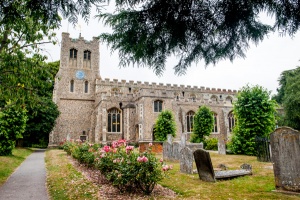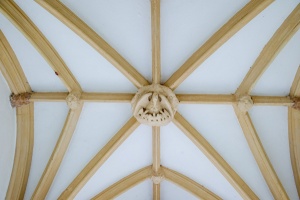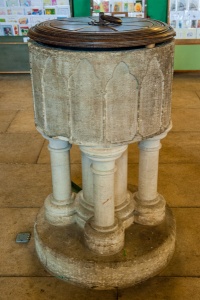
The Domesday Book of 1086 mentions a priest at Coggeshall, so we know there was a church on this site at least as early as the Norman Conquest, and probably well back into the Saxon period. The present large and spacious church is almost entirely 15th century Perpendicular Gothic, and must be one of the finest 15th century churches in Essex.
The sheer scale of the church speaks volumes about the prosperity of the East Anglian wool trade in the medieval period.
It is impossible to talk about the history of this wonderful Perpendicular church without mentioning very recent history. In September 1940 a German bomb landed directly on the church, causing enormous damage and destroying the tower and west end.
It was not until 1956 that restoration was completed, and as a result of the destruction many of the original medieval fittings were lost. A memorial marking the 50th anniversary of the rededication stands by the north door.

Flanking the south porch are a pair of carvings thought to represent Queen Matilda and King Stephen (early 12th century). The south tower door is fascinating, with medieval ironwork decoration depicting a crescent moon, noonday sun, and a cockerel crowing to announce the dawn.
Within the church, the font is Early English (i.e. probably 13th century) and predates the current church. It was brought here from Pattiswick, where it was being used as a horse-trough!
In the north chancel aisle is St Katherine's Chapel, where medieval brasses that survived the bomb damage are gathered together. One of the best brasses is the 16th century memorial to John and Johanne Peycocke (or Paycocke - medieval spelling is pretty variable).
The Peycockes were a prominent merchant family, and their townhouse on West Street is now owned by the National Trust. The oldest Peycocke tomb is that of Thomas Peycocke (d. 1518) and his two wives Margaret and Anne.
A brass to a later Thomas Peycocke (d. 1580) is nearby. The brasses on this tomb are palimpsests, that is, they are carved on the reverse of earlier brasses. In this case the original brasses came from the tomb of William Askham (d. 1480). A resin copy of the Askham brasses can be found mounted on the wall.

Early English font
Behind the high altar is an astonishing reredos, carved in alabaster and Caen stone. Though it looks medieval, it is actually Victorian, made as a memorial to William Dampier. Above the reredos is the colourful east window, by Clayton and Bell of London, one of the most famous stained glassmakers of the Victorian period. This was given by the Hanbury family as a memorial, and managed to escape the worst of the 1940 bombing.
The beautifully carved pulpit is another example of excellent Victorian craftsmanship, created in 1871 by WB Polley, a local carver. At the foot of the pulpit is an 18th-century marble to 5 infant children of Richard du Carne, Lord of the Manor at Coggeshall and an MP.
In the priest's vestry is a wonderful early 17th century wall memorial to Mary Honywood (d. 1620), who lived to the age of 93 and left 367 living descendants! The memorial was originally in Marks Hall church but was brought to Coggeshall when the church was made redundant in 1932. The vestry is usually shut, so you will have to make special arrangement to see the tomb.
In the south aisle are several memorials to the Townsend family, including that of Robert Townsend, who served with the Duke of Marlborough.
Across the River Blackwater, about a 20 minute walk from St Peter's, is the Gatehouse Chapel of St Nicholas, a mall 12th century chapel that stood at the entrance to the Cistercian Abbey of Coggeshall. The chapel is used for occasional worship and is closely linked to St Peter's.
Summing up
We loved visiting St Peter's. We arrived while a social gathering was going on, and we were made very welcome and encouraged to explore the church. And there's a lot to explore; I can only wonder what it must have been like before the bomb damage.
About Coggeshall
Address: Church Green,
Coggeshall,
Essex,
England, CO6 1QF
Attraction Type: Historic Church
Location: A short walk down Church Street from the market place. Thee is signposted town parking off Stoneham Street. The church is usually open daylight hours.
Website: Coggeshall
Location
map
OS: TL851227
Photo Credit: David Ross and Britain Express
NEARBY HISTORIC ATTRACTIONS
Heritage Rated from 1- 5 (low to exceptional) on historic interest
Coggeshall Museum - 0.1 miles (Museum) ![]()
Paycockes - 0.3 miles (Historic Building) ![]()
Coggeshall Abbey - 0.4 miles (Abbey) ![]()
Coggeshall Grange Barn - 0.4 miles (Historic Building) ![]()
Marks Hall Arboretum and Garden - 1.8 miles (Garden) ![]()
Cressing Temple Barns and Gardens - 4.1 miles (Historic Building) ![]()
Copford, St Michael and All Angels Church - 5.2 miles (Historic Church) ![]()
Halstead, Holy Trinity Church - 5.5 miles (Historic Church) ![]()











